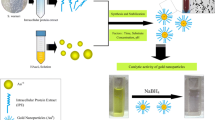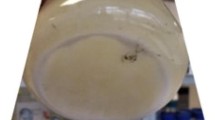Abstract
The fabrication of reliable, green chemistry processes for nanomaterial synthesis is an important aspect of nanotechnology. The biosynthesis of single-pot room-temperature reduction of aqueous chloroaurate ions by Streptomyces hygroscopicus cells has been reported to facilitate the development of an industrially viable greener methodology for the synthesis of technologically important gold nanoparticles (AuNPs). Multidimensional AuNPs are generated via the manipulation of key growth parameters, including solution pH and reaction time. The synthesized nanostructures are characterized by UV/Vis and energy dispersive X-ray analysis studies. Particle morphology is characterized by HRTEM, FE-SEM and BioAFM. Additionally, we have demonstrated the electrochemical and antibacterial properties of AuNPs via cyclic voltammetry analysis and a minimal inhibitory concentration assay. Owing to the drawbacks of chemical synthesis, a biological synthesis method has been developed to generate biocompatible, inexpensive and eco-friendly size-controlled nanoparticles.








Similar content being viewed by others
References
Ahmad A, Mukherjee P, Mandal D, Senapati S, Khan MI, Kumar R, Sastry M (2002) Enzyme mediated extracellular synthesis of CdS nanoparticles by the fungus, Fusarium oxysporum. J Am Chem Soc 124:12108–12109
Ahmad A, Senapati S, Khan MI, Kumar R, Sastry M (2003) Extracellular biosynthesis of monodisperse gold nanoparticles by a novel extremophilic actinomycete, Thermomonospora sp. Langmuir 19:3550–3553
Bethell D, Schriffrin DJ (1996) Nanotechnology and nucleotides. Nature 382:581
Brown S, Sarikaya M, Johnson E (2000) A genetic analysis of crystal growth. J Mol Biol 299:725–735
Brus LJ (1994) Luminescence of silicon materials: chains, sheets, nanocrystals, nanowires, microcrystals, and porous silicon. Phys Chem 98:3575–3581
Chun YJ, Shimada T, Waterman MR, Guengerich FP (2006) Understanding electron transport systems of Streptomyces cytochrome P450. Biochem Soc Trans 34:1183–1185
Dameron CT, Reese RN, Mehra RK, Kortan AR, Carroll PJ, Steigerwald ML, Brus LE, Winge DR (1989) Biosynthesis of cadmium sulphide quantum semiconductor crystallites. Nature 338:596–597
Duan XF, Huang Y, Agarwal R, Lieber CM (2003) Single nanowire electrically driven lasers. Nature 421:241–245
Grubbs RB (2007) Solvent-tuned structures. Nat Mater 6:553–555
Heath JR, Kuekes PJ, Snider GS, Williams SR (1998) A defect-tolerant computer architecture: opportunities for nanotechnology. Science 280:1716–1721
Herman A, Addadi L, Weiner S (1988) Interactions of sea-urchin skeleton macromolecules with growing calcite crystals a study of intracrystalline proteins. Nature 331:546–548
Hosea M, Greene B, McPherson R, Henzl M, Alexander MD, Darnall DW (1986) Accumulation of elemental gold on the alga Chlorella vulgaris. Inorg Chim Acta 123:161–165
Iosin M, Toderas F, Baldeck P, Astilean SJ (2008) In vitro biosynthesis of gold anotriangles for Surface-Enhanced Raman spectroscopy. Optoelectron Adv Mater 10:2285–2288
Johnson JC, Yan HQ, Schaller RD, Haber LH, Saykally RJ, Yang PD (2001) Single nanowire lasers. J Phys Chem B 105:11387–11390
Katz E, Willner I, Wang J (2004) Electroanalytical and bioelectroanalytical systems based on metal and semiconductive nanoparticles. Electroanalysis 16:19–44
Klaus T, Joerger R, Olsson E, Granqvist CG (1999) Silver-based crystalline nanoparticles, microbially fabricated. Proc Natl Acad Sci USA 96:13611–13614
Komeili A, Vali H, Beveridge TJ, Newman DK (2004) Magnetosome vesicles are present before magnetite formation, and MamA is required for their activation. Proc Natl Acad Sci USA 101:3839–3844
Kroger N, Deutzmann R, Sumper M (1999) Polycationic peptides from diatom biosilica that direct silica nanosphere formation. Science 286:1129–1132
Labrenz M, Druschel GK, Ebert TT, Gilbert B, Welch SA, Kemner KM, Logan GA, Summons RE, Stasio GD, Bond PL, Lai B, Kelly SD, Banfield JF (2000) Sphalerite (ZnS) deposits forming in natural biofilms of sulfate reducing bacteria. Science 290:1744–1747
Lang C, Schuler D, Faivre D (2007) Synthesis of magnetite nanoparticles for bio- and nanotechnology: genetic engineering and biomimetics of bacterial magnetosomes. Macromol Biosci 7:144–151
Lee J, Hwang S, Lee H, Kwak J (2004) Bimetallic clusters by underpotential deposition on layered Au nanoparticle films. J Phys Chem B 108:5372–5379
Lovley DR, Stolz JF, Nord GL Jr, Phillips EJP (1987) Anaerobic production of magnetite by a dissimilatory iron-reducing microorganism. Nature 330:252–254
Mukherjee P, Ahmad A, Mandal D, Senapati S, Sainkar SR, Khan MI, Ramani R, Parischa R, Ajayakumar PV, Alam M, Sastry M, Kumar R (2001) Bioreduction of AuCl4 − ions by the fungus, Verticillium sp. and surface trapping of the gold nanoparticles formed. Angew Chem Intl Edn Eng 40:3585–3588
Ouhdouch Y, Barakate M, Finance C (2001) Actinomycetes of Moroccan habitats: isolation and screening for antifungal activities. Eur J Soil Biol 37:69–74
Ragupathy D, Gopalan AI, Lee K-P (2010) Electrocatalytic oxidation and determination of ascorbic acid in the presence of dopamine at multiwalled carbon nanotube-silica network-gold nanoparticles based nanohybrid modified electrode. Sensor Actuat B: Chem 143:696–703
Sadhasivam S, Shanmugam P, Yun KS (2010) Biosynthesis of silver nanoparticles by Streptomyces hygroscopicus and antimicrobial activity against medically important pathogenic microorganisms. Colloid Surf B: Biointerfaces 81:358–362
Sastry M, Patil V, Sainkar SRJ (1998) Electrostatically controlled diffusion of carboxylic acid derivatized silver colloidal particles in thermally evaporated fatty amine films. Phys Chem B 102:1404–1410
Schmid G (1998) Lifeng CF metal clusters and colloids. Adv Mater 10:515–526
Senapati S, Ahmad A, Khan MI, Sastry M, Kumar R (2005) Extracellular biosynthesis of bimetallic Au–Ag alloy nanoparticles. Small 1:517–520
Shaojun G, Erkang W (2007) Synthesis and electrochemical applications of gold nanoparticles. Anal Chim Acta 598:181–192
Shirling EB, Gottlieb D (1966) Methods for characterization of Streptomyces species. Int J Syst Bacteriol 16:313–340
Tang ZY, Kotov NA, Giersig M (2002) Spontaneous organization of single CdTe nanoparticles into luminescent nanowires. Science 297:237–240
Veerapandian M, Subbiah R, Lim G-S, Park S-H, Yun KS, Lee M-H (2011) Copper–glucosamine microcubes: synthesis, characterization and C-reactive protein detection. Langmuir 27:8934–8942
Williams ST, Sharp ME, Holt JG (1989) Bergey’s manual of systematic bacteriology, vol 4. Williams and Wilkins, Baltimore, pp 2492–2504
Wong SS, Joselevich E, Woolley AT, Cheung CL, Lieber CM (1998) Covalently functionalized nanotubes as nanometer probes for chemistry and biology. Nature 394:52–55
Xiaoxiao H, Xu W, Kemin W, Bihua S, Luo H (2009) Methylene blue-encapsulated phosphonate-terminated silica nanoparticles for simultaneous in vivo imaging and photodynamic therapy. Biomaterials 30:5601–5609
Acknowledgment
This work was supported by Kyungwon University research fund in 2011(2011-R295).
Author information
Authors and Affiliations
Corresponding author
Rights and permissions
About this article
Cite this article
Sadhasivam, S., Shanmugam, P., Veerapandian, M. et al. Biogenic synthesis of multidimensional gold nanoparticles assisted by Streptomyces hygroscopicus and its electrochemical and antibacterial properties. Biometals 25, 351–360 (2012). https://doi.org/10.1007/s10534-011-9506-6
Received:
Accepted:
Published:
Issue Date:
DOI: https://doi.org/10.1007/s10534-011-9506-6




